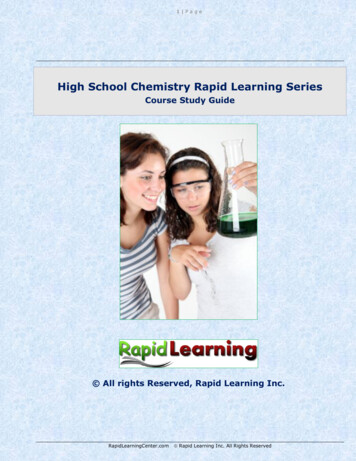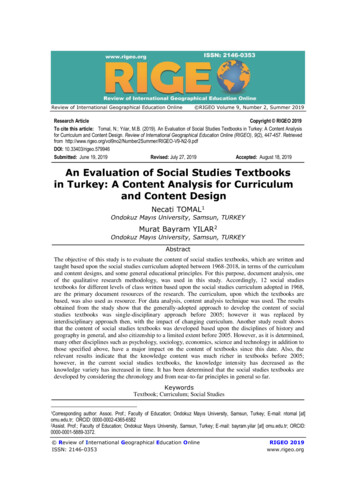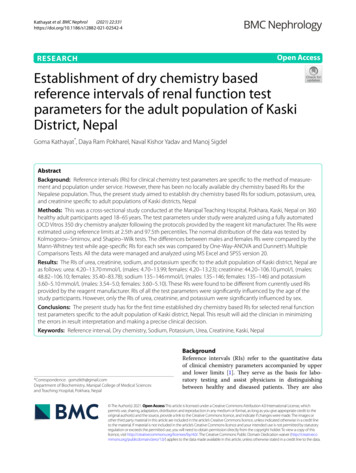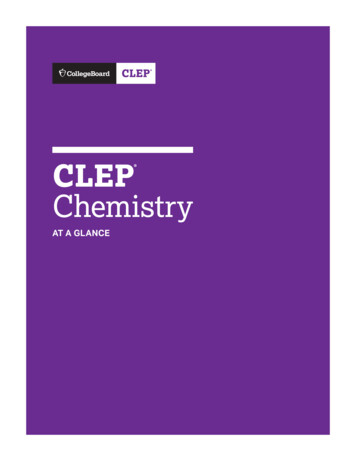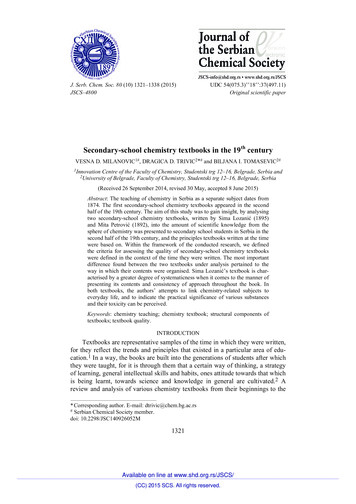
Transcription
J. Serb. Chem. Soc. 80 (10) 1321–1338 (2015)JSCS–4800UDC 54(075.3)’’18’’:37(497.11)Original scientific paperSecondary-school chemistry textbooks in the 19th centuryVESNA D. MILANOVIC1#, DRAGICA D. TRIVIC2*# and BILJANA I. TOMASEVIC2#1InnovationCentre of the Faculty of Chemistry, Studentski trg 12–16, Belgrade, Serbia andof Belgrade, Faculty of Chemistry, Studentski trg 12–16, Belgrade, Serbia2University(Received 26 September 2014, revised 30 May, accepted 8 June 2015)Abstract: The teaching of chemistry in Serbia as a separate subject dates from1874. The first secondary-school chemistry textbooks appeared in the secondhalf of the 19th century. The aim of this study was to gain insight, by analysingtwo secondary-school chemistry textbooks, written by Sima Lozanić (1895)and Mita Petrović (1892), into the amount of scientific knowledge from thesphere of chemistry was presented to secondary school students in Serbia in thesecond half of the 19th century, and the principles textbooks written at the timewere based on. Within the framework of the conducted research, we definedthe criteria for assessing the quality of secondary-school chemistry textbookswere defined in the context of the time they were written. The most importantdifference found between the two textbooks under analysis pertained to theway in which their contents were organised. Sima Lozanić’s textbook is characterised by a greater degree of systematicness when it comes to the manner ofpresenting its contents and consistency of approach throughout the book. Inboth textbooks, the authors’ attempts to link chemistry-related subjects toeveryday life, and to indicate the practical significance of various substancesand their toxicity can be perceived.Keywords: chemistry teaching; chemistry textbook; structural components oftextbooks; textbook quality.INTRODUCTIONTextbooks are representative samples of the time in which they were written,for they reflect the trends and principles that existed in a particular area of education.1 In a way, the books are built into the generations of students after whichthey were taught, for it is through them that a certain way of thinking, a strategyof learning, general intellectual skills and habits, ones attitude towards that whichis being learnt, towards science and knowledge in general are cultivated.2 Areview and analysis of various chemistry textbooks from their beginnings to the* Corresponding author. E-mail: dtrivic@chem.bg.ac.rs# Serbian Chemical Society member.doi: 10.2298/JSC140926052M1321Available on line at www.shd.org.rs/JSCS/(CC) 2015 SCS. All rights reserved.
1322MILANOVIC, TRIVIC and TOMASEVICpresent day affords insight into the development of ideas about chemistry and theintellectual achievements of many generations of students in the realm of thisscience.3 A textbook reflects the characteristics of the context that it was createdin, as well as the academic knowledge and beliefs of its author(s), reflecting theirviews of what science is or what it should be.4 It may be viewed as a conversation between chemistry as a scientific discipline, the context for teaching/learning, the author’s personal characteristics and the burden that each societyimposes upon one.5 Textbook writers are confined to the margins of scientificcommunities, they share various cultures and they are under strong social, economic, and political pressures.6 Moreover, textbooks are read and used by a greatvariety of audiences with different aims, expectations and reading practices. Scientific textbooks are, therefore, at the crossroad between disciplines such as theof science, the history of education and the history of books and reading.7 Byanalysing textbooks that were used in the past, one can form a picture of thequality of teaching at that time can be formed. Insight can be gained into therelationship between science and education, into how fast scientific knowledgewas built, into the process of education and the extent to which they representeda response to the needs of society at the time. It could be said that textbooks aresorts of archaeological traces of former regimes of knowledge.6 Textbooks canbe viewed as focal points for many of the historical contingencies that shape notonly scientific practice, but also the roles of science and scientists in society.Although most easily treated as part of the history of the book, they also carryhistorical significances that transcend that genre.8Textbooks turned into an independent and characteristic genre of scientificpublication in the 19th century when science education became compulsory in anumber of European universities as well as in primary and secondary education.A reason for the rise of the textbook was its instrumentality in the developmentof the national structures of education, in particular, the nineteenth-centuryimplementation of secondary education.9The teaching of chemistry as an independent subject in secondary schools inSerbia dates back to 1874.10 Prior to that, chemistry was studied within theframework of physics and mineralogy. It was taught in the fourth grade, fourclasses per week. In the guidelines sent to teachers in 1874, it is stated thatinorganic and organic chemistry with experiments should be taught. Of the fourclasses per week, one had to be dedicated to conducting experiments, which isindicative of the significance attached to experimental work in the course ofteaching chemistry.By analysing two secondary-school chemistry textbooks written by SimaLozanić (1895) and Mita Petrović (1892), the aim of this study was to gaininsight into the amount of scientific knowledge from the sphere of chemistryAvailable on line at www.shd.org.rs/JSCS/(CC) 2015 SCS. All rights reserved.
thCHEMISTRY TEXTBOOKS IN THE 19 CENTURY1323presented to young people in Serbia in the second half of the 19th century, andinto principles on which textbooks written at the time were based.Sima Lozanić (1847–1935) was a chemist, scientist, Professor, Chairman ofthe Academy of Sciences, the first Rector of Belgrade University, Ambassador toLondon, Minister of the Economy and Minister of Foreign Affairs, a diplomat. Inthe mid-1880’s, at the time of a reform and modernisation of grammar schools,Lozanić worked on compiling a modern chemistry curriculum and introducingteaching through experiments in secondary schools.11 Apart from chemistry,Sima Lozanić also studied pedagogy (1868–1870) at the well-known school ofpedagogy in Küsnacht near Zurich. At Zurich University, Lozanić studied chemistry under Johannes Wislicenus (1835–1902), and subsequently spent one yearat the August Wilhelm von Hofmann’s (1818–1892) laboratory for organicchemistry.12For many years, Mita Petrović (1848–1891) worked at the Serbian Teachertraining School in Sombor, where he taught mathematics and natural sciences.He had organized and equipped a chemical laboratory in Sombor where he didresearch in the sphere of natural sciences, especially physics and chemistry. Healso wrote a large number of textbooks on all subjects he taught. These weremainly based on contemporary German language textbooks which Petrović translated and adjusted to the level and needs of his students. He was a correspondentmember of the Serbian Academy of Science, and member of numerous otherlearned societies. Mita Petrović received many accolades for his work.13The rules on writing secondary-school textbooks in Serbia were passed in1895. A commission was formed the task of which was to establish whether suitable textbooks existed for all the subjects taught at school. In March 1895, thecommission informed the Board of Education that there was no suitable chemistry textbook for the fourth grade of grammar school. Within one year, Lozanićwrote a textbook and submitted it for publication in March 1896 (although on thecover 1895 remained as the year of publication). In March 1896, Lozanić sent thetextbook to the Minster of Education and to the Board of Education for review.The reviewer Marko Leko submitted a negative review, containing 36 objections,of the textbook to the Board.14The Board of Education, which was composed of secondary school teacherswho opposed Lozanić’s terminology, decided not to accept Lozanić’s book as anofficial textbook. It was in vain that Lozanić tried to respond to the criticismsaddressed to him.15–19 Through the Board of Education, the polemic betweenhim and Leko continued throughout 1897, until The Ed ucational Gazetteannounced that the editorial board would accept no further correspondence pertaining to the said polemic. Lozanić’s textbook was only recommended for use insecondary schools at the beginning of the 20th century. Until then, Mita Petrović’s textbook was used.11Available on line at www.shd.org.rs/JSCS/(CC) 2015 SCS. All rights reserved.
1324MILANOVIC, TRIVIC and TOMASEVICTHE METHODOLOGY OF THE RESEARCHThe textbook sample analysed within the framework of this research was the first editionof Sima Lozanić’s textbook Chemistry for Secondary Schools, dating from 1895, and the thirdedition of Mita Petrović’s textbook Chemistry for S econdary Schools, based on Prokop Prohaszka and Others, dating from 1892. Sima Lozanić’s textbook had a total of five editions(1895, 1897, 1903, 1910, and 1925). For the purpose of this analysis, the first edition waschosen in view of the above-mentioned criticism, which reflects the context in which the textbook was created.Mita Petrović’s textbook, despite the fact that it was not in accordance with the curriculum dating from 1881, was used in schools with the permission of the Ministry of Educationuntil the beginning of the 20th century, even after the publication of Sima Lozanić’stextbook.12 The first edition of this textbook came out in 1883, but herein, the third edition,dating from 1892, was analysed as the preceding two editions were not available.In order to achieve the set goal, first a methodology for analysing and evaluating thequality of these textbooks within the context of the period when they were created requireddevelopment.Some characteristics of a textbook can be quantified, whereas others require a qualitativeanalysis. The main purpose of the qualitative approach is to understand and interpret variousmeanings that the textbook being analysed carries, following which the elements of the meanings are established.20 The present analysis of the selected secondary-school chemistry textbooks dating from the 19th century was supposed to provide answers to the followingquestions:1. What contents were presented in the chemistry textbooks from the second half of the19th century?2. To what extent were the contents presented in the examined textbooks in keepingwith the then current level of knowledge in chemistry?3. What experiments are presented and described in the textbooks?4. To what extent did the textbooks analysed establish a connection between thetextbook contents and everyday life?5. To what extent does the textbook caution the students to take care when dealing withcertain substances?6. To what extent were the contents of the textbooks in keeping with the chemistrycurriculum then in effect?7. To what extent did the textbooks deal with events from the history of chemistry?8. How were the analysed textbooks supported in terms of graphic design and illustrations?9. What were the structural and organisational components of the analysed textbooks?10. How were the contents of the textbooks shaped in terms of didactics?The chemistry-related contents of the analysed textbooks were followed through thefollowing: the themes, the index, the symbols and names of the elements mentioned in thetextbook, the formulas of chemical compounds and their names, the equations depictingparticular chemical reactions. With the exception of the themes reviewed, all the otherparameters monitored within the framework of this part of the research were quantified. Thedegree to which the contents of the analysed textbooks were in keeping with the current levelof knowledge in chemistry was assessed based the presence of current discoveries in thesphere of chemistry in the text (for example, the discovery of the periodical system of theelements, the Arrhenius theory of acids and bases, etc.).Available on line at www.shd.org.rs/JSCS/(CC) 2015 SCS. All rights reserved.
thCHEMISTRY TEXTBOOKS IN THE 19 CENTURY1325The extent to which the students’ understanding of chemistry was supported throughexperiments was also monitored. The experiments described in chemistry textbooks brings thequestion whether laboratory techniques can be appropriated by students when reading textbooks and provide information about the teaching practices in the context of the localresources.6 The possibilities for developing meanings on the basis of the textbook (the meaningfulness of the textbook material) and insight into the practical importance of the knowledgeof chemistry were monitored on the basis of the existing links between the chemistry-relatedcontents and their application in everyday life, and also on the basis of indicating the toxicityof certain substances, their influence on human health and precautions to be taken whendealing with such substances.The contents of the analysed textbooks were compared with the chemistry curriculumfrom 1881, the latter being closest in time to their publication dates.On the basis of the presence of contents related to the history of chemistry, we reviewedthe extent to which the textbooks supported the development of an appropriate idea of thisscience in the students’ minds.21,22 Furthermore, we monitored the ways in which the analysedtextbooks were supported in terms of illustrations and graphic design and what kind of information was supplied through the illustrations, i.e., what was their purpose, were monitored.One of the ways of checking the extent to which textbooks achieve their aims is to evaluatethe questions that they contain.23 In the textbooks analysed, the thought processes that theyinitiated, i.e., the form of learning they initiated, were evaluated.The structural and organisational components that were monitored within the frameworkof this analysis are given in Table S-I of the Supplementary material to this paper.The content of a textbook should be didactically shaped in such a way that it ensures thestudents’ minds are activated, that the basic structure of knowledge is accepted by those forwhom the textbook is intended.20 The indicators of didactic organisation that were followed inthe analysed textbooks were as follows: I) the existence of scientific terms, II) the functionaluse of pictorial means of expression, III) the diversity of the examples provided, IV) themeaningfulness of the organisation of the textbook contents and V) whether the textbookmaterial has any connection with everyday life out of school.Whether the language of the textbook in question was compatible with the currentlanguage of the science of chemistry at the time when the textbooks analysed were writtenwas also monitored during the analysis of the textbooks.RESULTS AND DISCUSSIONFrom the introductory statements of both textbooks, their intentions andviews on how the study of chemistry should be organised could be seen.In the preface to the first edition of his textbook, Sima Lozanić pointed outthat students found it easier to understand the formulation of the laws of chemistry based on experiments conducted in class. He was of the opinion that it waseasier for beginners to learn about general terms in the sphere of chemistry in aseparate section of the book and that by doing so enabled the presentation of thispart in a systematic manner, thus forming a basis for understanding inorganic andorganic chemistry. The method of “placing the general part within the frameworkof a special part”, which was included in the curriculum, could lead to learningwithout real understanding. In his introductory statement, Sima Lozanić explained that his approach to organising the contents of organic chemistry wasAvailable on line at www.shd.org.rs/JSCS/(CC) 2015 SCS. All rights reserved.
1326MILANOVIC, TRIVIC and TOMASEVICthrough homologous series. He stressed that he paid greater attention to appliedchemistry and to interpreting chemical phenomena in nature, for he was of theopinion that in this way “young men were not only enriched through knowledgebut also developed a greater interest in science”.At the beginning of the third edition of Mita Petrović’s textbook Chemistryfor Secondar y Schools, b ased on Pro kop Prohasz ka and Othe rs, dating from1892, the preface to the first edition of this textbook, dating from 1883, isincluded. In this preface, Mita Petrović states that the presentation of the contentsof chemistry, the body of knowledge of which has greatly increased, in a mannersuitable for beginners to this area, while at the same time including its development as a science, is a problem. He indicated that the organisation of the textbookmaterial was such that the theoretical explanations provided by chemistry werenot given in succession, but alternated with experimental parts, and were placedso that the students should be able to understand them when they reached them.In his opening statement, the author pointed out that, when deciding on the scopeof the textbook material, he was guided by the curriculum prescribed for grammar schools in the Kingdom of Serbia.The quantitative data on the analysed textbooks are presented in Table S-IIof the Supplementary material. The scope of the textbook material in the analysed textbooks differs: Sima Lozanić’s textbook has 163 pages, whereas MitaPetrović’s textbook has 110 and is smaller in format. In Sima Lozanić’s textbook,the table of chemical elements, containing their symbols, names and atomicmass, comprises 68 elements, of the 70 that were known at the time. The tablepresented in Mita Petrović’s textbook contains such data for 36 elements. InSima Lozanić’s textbook, there are a greater number of chemical formulas. Thoseare, for the most part, molecular formulas, whereas the number of structural formulas is small in both textbooks.Both textbooks comprise contents related to general, inorganic and organicchemistry. In Sima Lozanić’s textbook, the contents are organised into threesections: general chemistry, inorganic chemistry and organic chemistry. Following a brief opening part, explaining several fundamental terms in the sphere ofchemistry, the contents of Mita Petrović’s textbook are organised into two sections: inorganic chemistry and organic chemistry.These two textbooks differ in how their contents are organised. Sima Lozanić’s textbook first explains the basic concepts, principles and laws in the sphereof chemistry, and only then proceeds to consider inorganic chemistry through thefamilies of elements, and organic chemistry through the classes of compoundsand homologous series. In Mita Petrović’s textbook, the material related to inorganic chemistry, within the framework of which chemical elements are consideredindividually, is interspersed with segments of material in which general chemicalAvailable on line at www.shd.org.rs/JSCS/(CC) 2015 SCS. All rights reserved.
thCHEMISTRY TEXTBOOKS IN THE 19 CENTURY1327principles and laws are reviewed (which is referred to as “placing the general partwithin the framework of a special part”).In the general section of Sima Lozanić’s textbook, the fundamental conceptsand laws in the sphere of chemistry, the division of elements into metalloids andmetals, and the nomenclature of chemical compounds are explained. The following fundamental chemical laws are discussed: the law of constant mass ratio, thelaw of multiple proportions, the law of conservation of mass, and Avogadro’slaw. The material is conceived in such a way that the corresponding experiments,or the results of experiments that preceded the discovery of the law in questionare first presented, followed by the formulation of the law. At the end of thegeneral section, the author explains how the remainder of the textbook is organised, announcing that the most important elements and compounds are discussed, that carbon compounds are especially emphasised because they are so numerous, and thus, that the entire sphere of chemistry is divided into two parts:inorganic chemistry, within the framework of which elements and their compounds are presented, and organic chemistry, within the framework of which carbon compounds are studied.As opposed to the general section of Sima Lozanić’s textbook, which contains 28 subtitles, in the opening section of Mita Petrović’s textbook, there arefour subtitles. In the section entitled Things change, various kinds of physical andchemical changes known from everyday life are presented (changes in the aggregation state of water, sliding a bow across a string, charging a resin bar with electricity, sliding a magnet across steel, the dissolution of sugar in water, the burning of wood and the fermentation of grapes). In the section entitled Transient andessential changes, differences between the types of changes are presented, whichis followed by their classification into two groups and finally their definition asphysical and chemical changes. In the section entitled The directions of chemicalchanges, some experiments are presented, following which the meanings of theterms analysis and synthesis are defined. The last section in the introductory partof the textbook is entitled The difference between a mixture and a compound, inwhich the difference between the two is defined.In the section of Sima Lozanić’s textbook that deals with inorganic chemistry, the chemical elements are presented based on the family of elements towhich they belong, They are considered in the following order: the hydrogenfamily (Н), the halogen family (F, Cl, Br and I), the oxygen family (O, S, Se andTe), the nitrogen family (N, P, As, Sb, Bi, B, V, Nb and Ta), the carbon family(C, Si, Ge, Sn, Ti, Zr and Th), the alkali family (Li, Na, K, Rb and Cs), the earthalkali family (Ca, Sr and Ba), the magnesium family (Be, Mg, Zn and Cd), themercury family (Hg, Cu, Ag and Au), the lead family (Pb), the aluminium family(Al, Ga, In, Tl, Ce, La, Di, Sm, Y, Er, Yb and Sc), the iron family (Fe, Co, Ni, Crand Mn), the platinum family (Pt, Pd, Ir, Rh, Ru and Os) and the molybdenumAvailable on line at www.shd.org.rs/JSCS/(CC) 2015 SCS. All rights reserved.
1328MILANOVIC, TRIVIC and TOMASEVICfamily (Mo, W and Ur). A consistent manner of presentation was used for eachof the above families of chemical elements. First the name of the family is given,followed by an enumeration of all elements belonging to it, together with theirvalences, and then the elements are studied individually. The organisation of thepresentation of material when considering each individual element is as follows:after the section title, which contains the name of the element in Serbian and, inmost cases, in Latin, its atomic mass, as well as molecular mass if the elementoccurs in nature in molecular form, the author proceeds to speak of the forms inwhich it occurs in nature, both in its elementary state and as part of compounds,then of the ways in which it can be obtained, its physical and chemical properties,and finally of its use, that is, its practical application. The physical properties include the state of aggregation, colour, taste, solubility in water and less polar solvents, for example, alcohol and CS2. The chemical properties include the reactivity of the given element with some other element or compound. Concerningthe use of elements, first their use in everyday life is presented, be it in their elementary state or in compounds. This order of presentation of the material isretained when considering the important compounds of the elements previouslypresented. In the case of compounds where characteristics analogous to those ofpreviously presented compounds featuring elements of the same family can beobserved, the similarity in their physical and chemical characteristics are emphasised. At the beginning of the presentation of the majority of the elements, theyear when a particular element was discovered and who discovered it are brieflymentioned. In the section dealing with nitrogen, a three-atom molecule of nitrogen, N3, referred to as argon, as an allotropic modification of nitrogen, analogouswith oxygen and ozone, was mentioned (which was deleted from the next editionof the textbook, published in 1897). The mention of N3 as an allotropic modification of nitrogen was criticised by Marko Leko, and constitutes one of his objections contributing to his negative review of the textbook.A lot of attention is paid to ores and minerals that contain certain elementsand to where they can be found, and the most important mines are enumerated,both in Serbia and outside its boundaries at the time. This points to the significance of mineralogy and to the importance that was attached to it in the sphereof education in the 19th century.As was already stated, the contents of the inorganic chemistry section of thetextbook Chemistry for Secondary Schools, based on Prokop Prohaszka andOthers are organised based on the principle of “placing the general part withinthe framework of a special part”, which was applied in the chemistry curriculumdating from 1881. This textbook contains separate sections for studying metalsand non-metals. The section dealing with non-metals includes a lot of subjectsfrom the sphere of general chemistry, alternating with segments wherein thecharacteristics of individual elements and their compounds are considered. TheAvailable on line at www.shd.org.rs/JSCS/(CC) 2015 SCS. All rights reserved.
thCHEMISTRY TEXTBOOKS IN THE 19 CENTURY1329textbook section entitled Metals deals with individual metals and their characteristics. The presentation of the contents related to inorganic chemistry begins withthe section entitled On air. At the very beginning of this section, the followingexperiment is described – the heating of tin inside a closed vessel, along withmeasuring the mass of the solid substances before and after the reaction, identicalto the one on which Lavoisier (Antoine Laurent Lavoisier, 1743–1794) established the Law of conservation of mass. However, Lavoisier’s work is not mentioned here, nor is the law that he discovered; the latter is subsequently explicitlystated within the framework of the section entitled The quantitative ratios ofcompounds. There follows a description of experiments for obtaining nitrogenand oxygen. After this, the characteristics of oxygen and nitrogen are discussedindividually, primarily the physical ones, and when considering the characteristics of oxygen, the process of oxidation and the creation of oxides are explained. The next section is entitled On water , and it considers hydrogen. Theauthor expounds on the dilemma of whether hydrogen should be classifiedamong non-metals or metals. There follows a general part again in which the following are defined: chemical affinity, atoms and molecules. After neutralisation,there is a detailed presentation of chlorine and sulphur (the way they appear innature, how they are obtained, their properties, use, etc.). Within the frameworkof the section entitled The quantitative ratios of compounds , for the first time anequation of a chemical reaction is presented, namely, the one depicting thecreation of water, wherein the reactants are presented in their atomic form.Within the next section, entitled The important compounds of the elements considered so f ar, the following compounds are presented: HCl, H2S, HNO3(HO·NO2), NO2, NO, H2SO4 and (HO)2SO4. Described is how they occur innature, how they are obtained, their properties and their use. The next element tobe considered is carbon, its allotropic modifications, and the types of coal.Particular attention is paid to the sites of coal deposits and the sources of mineralwater in Serbia. Together with carbon, its compounds are considered, which wasnot the case for the preceding elements. Valence, as a topic belonging to thegeneral section, is introduced after carbon. There follows a section entitled Onflame and burning , wherein the last considered non-metal, phosphorus is introduced.At the beginning of the section dealing with the study of metals, it is statedthat metals are divided into light and heavy ones. The light metals are: K, Na, Ca,Mg, Ba, Sr and Al. The others are heavy metals. What is presented next is thedivision of metals based on valence follows: one-valence metals (K, Na and Ag),two-valence metals (Ba, Sr, Ca, Mg, Zn, Cd, Pb, Cu and Hg), three-valencemetals (Bi and Au), four-valence metals (Al, Mn, Fe, Co, Ni and Cr). It ispointed out that some metals, as well as some non-metals, have more than onevalence, that they form two lines of compounds, but that it is still not knownAvailable on line at www.shd.org.rs/JSCS/(CC) 2015 SCS. All rights reserved.
1330MILANOVIC, TRIVIC and TOMASEVICwhat valence depends on and how it changes, except that it often occurs at hightemperatures. Subsequently, the important metals and metal compounds are studied individually, and it should be noted that the “affinity” of certain metals isstressed. The section of Mita Petrović’s textbook dealing with inorganic chemistry ends with an explanation of the spectral analysis method and a descriptionof the main parts of the spectroscope. As opposed to Mita Petrović’s textbook,spectral analysis is not dealt with in Sima Lozanić’s textbook, even though in thegeneral section of the textbook, the author did mention the importance of thismethod and said that he would discuss it later.At the beginning of the section dealing with organic chemistry, Sima Lozanić states that organic chemistry studies carbon compounds, whether those in the“kingdom of life” or those artificially produced in laboratories. Then he presents aclassification of organic compounds based on their composition: h
2University of Belgrade, Faculty of Chemistry, Studentski trg 12–16, Belgrade, Serbia (Received 26 September 2014, revised 30 May, accepted 8 June 2015) Abstract: The teaching of chemistry in Serbia as a separate subject dates from 1874. The first secondary-school chemistry t






